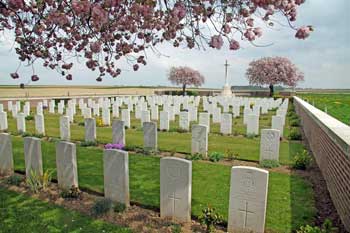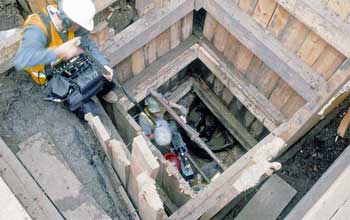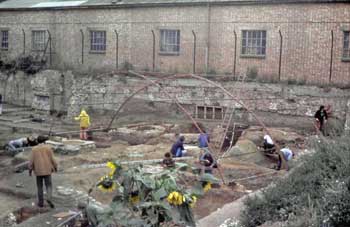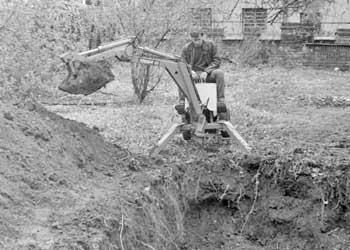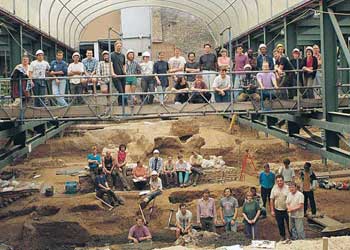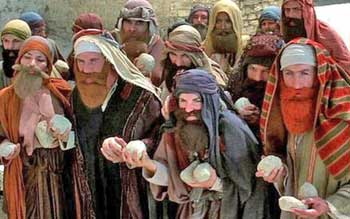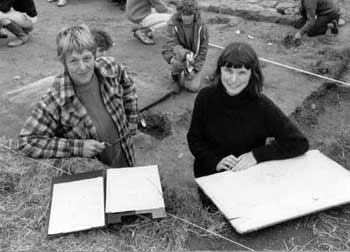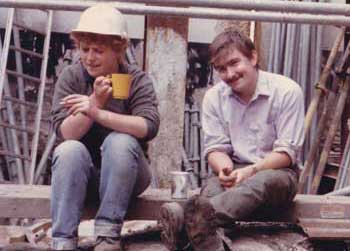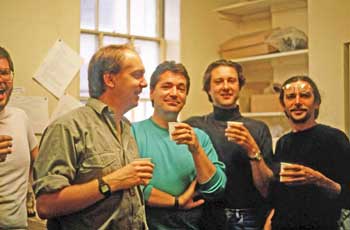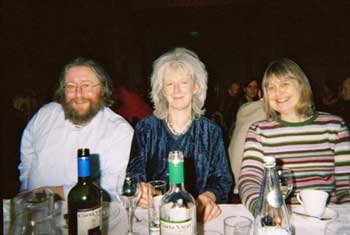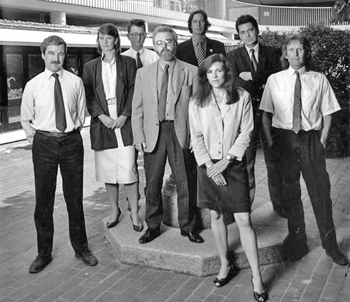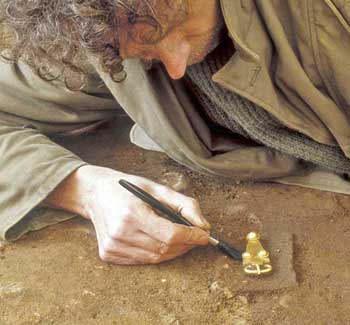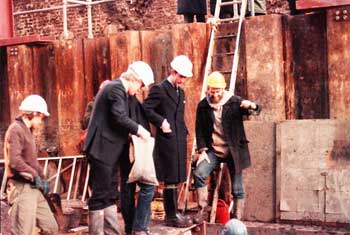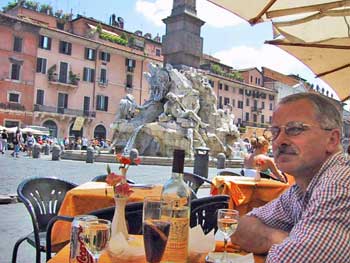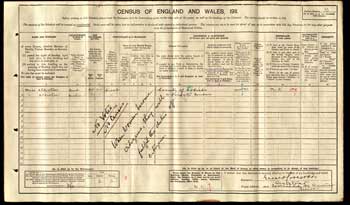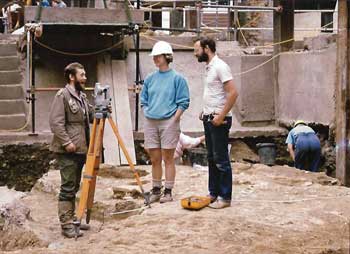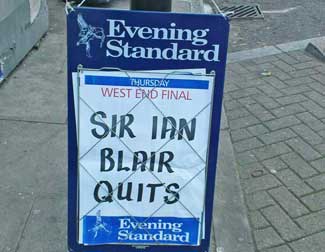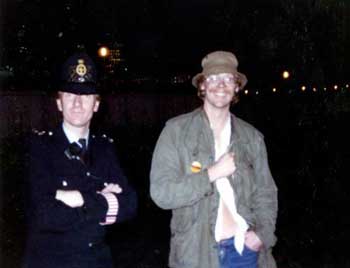‘Does an angel contemplate my fate, and do they know, the places where we go, when we're grey and old’: the young archaeologists of Paternoster Square
Ian Blair
During the summer of 1978 when the majority of the DUA archaeologists were engaged on the excavation of the GPO Newgate Street site (GPO75), we would frequently utilise the wide-open windswept spaces of Paternoster Square across the road, for a variety of outdoor recreational pursuits. One lunchtime session captured by a passing photographer of the City Recorder shows the: ‘Young archaeologists of the Museum of London’s Department of Urban Archaeology’ playing ‘Bocce’ the Italian version of Boule.
'The Fallen: rediscovering a lost generation'
Ian Blair
In August 2018 I wrote a short post ‘The Fallen: remembering a lost generation’ which detailed a journey I made to a Commonwealth War Graves Cemetery at St Amand in France, to mark the 100th anniversary of the death in World War One of my Great Uncle George William Alfred Blair.
‘I keep saying another metre and that will be it, but I said that 2m ago’: The excavation of the massive Roman wells and their bucket chains at 20-30 Gresham Street
Ian Blair
In 2001 a film crew followed the nine-month long excavation at 20-30 Gresham Street (GHT00), also known as Blossoms Inn, for a Time Team Special ‘Londinium, The Edge of Empire’ which aired a year later in April 2002:
Sunflowers and Polyspans
Ian Blair
Calverts Buildings, 15–23 Southwark Street, SE1 (15SKS80)
Looking at this photo evoked some random thoughts on polyspans and horticulture on archaeological sites in the period: It was good to see that the DGLA in common with the DUA employed the same weighty iron frame polyspans on site.
Archaeology working on the edge: Rectory Grove, Clapham
Ian Blair
Trial work by the Southwark and Lambeth Archaeological Excavation Committee (SLAEC) at Rectory Grove, Clapham, began in June 1980, and the photos show a youthful Hedley Swain operating a micro-excavator the likes of which I have not seen before, but perhaps it was a much-loved Christmas present?
‘Never trust a man with a balloon’: the aerial photography of the Guildhall amphitheatre
Ian Blair
For inexplicable reasons now lost in the mists of time, a man with a balloon (with I assume a camera slung beneath it on an umbilical),as opposed to a Montgolfier brothers style balloon launch from the Guildhall Yard, had been booked to take aerial photographs of the Roman amphitheatre, something that perhaps for very good reason, had never been tried before on an archaeological site in the City of London.
‘Welcome to the house of fun’
Ian Blair
The dynamics of any archaeological excavation is largely driven by the personalities of the individuals who participated. This was amply illustrated on a small DUA site at 61 Queen Street in the City of London (QUN85), supervised by Mark Burch between October 1985-January 1986. By this point in the DUA’s evolution, most of the archaeologists had known one another for many years, and were now part of a close-knit family, who not only worked together, but played together.
‘The Two Sues: MOLA Managing Editors par excellence’:
Unsung heroes of London archaeology No. 173
Ian Blair
The two Sues as they are fondly known, arrived as a pair at MOLA in 2000 as Managing Editors for the Greater London Publication Programme funded by Historic England to deal with selected sites from pre-1992,and remained with MOLA for the next 21 years.
Early on-site assessment of archaeological competency
Ian Blair
Peter Hinton with luxuriant flowing locks to rival those of Gustav Milne* in the Department of Urban Archaeology (DUA), seen relaxing at Chaucer House in Southwark in 1975/76, musing if the archaeologists toiling away in the background, might qualify for ‘Practitioner (PCIfA)’ level membership of a future Chartered Institute for Archaeologists.
In memory of Gina Porter
1957-2021
Ian Blair
The last few months have been awful in terms of the news of the untimely deaths of Pete Clark and Eric Norton,and this has been compounded in the last week, when I learnt of the passing of Gina Porter. It is hard right now to process this and find adequate words to describe how I feel today as she is laid to rest.
Remembering Eric Norton
Ian Blair
1st July 2021
On Monday I returned to Eagle Wharf Road for the first time in fifteen months, and it was great to see some of my former colleagues after such a long absence from MOLA. Much sadder news however was relayed by Derek Seeley, that Eric Norton had recently died.
‘Please Sir, can I have some more?’
Ian Blair
A lovely photo of Geoff Egan, Penny MacConnoran, and Anne Davis at the Guildhall Christmas lunch around 2008. This annual institution was always well attended by the archaeological fraternity, as there were always copious amounts of alcohol to be imbibed, and raucous support to be offered to Carol Thompson as she sought yet again to win the best fancy Christmas hat competition.
The assault on St Paul’s Cathedral: or how to gain entry after midnight
Ian Blair
I have lost count of the number of mad-cap suggestions fuelled by alcohol, that have been aired after long evenings spent in City hostelries:two of the most common being to run the London Marathon, or to leap out of an airplane, with I hasten to add a parachute.
No one messes with: ‘The Management!’
Ian Blair
The photo below shows Brian Hobley (Chief Urban Archaeologist) and senior DUA staff in 1978 and featured in ‘The City of London Archaeological Trust Appeal’ booklet, launched in an endeavour to raise extra funds for archaeology in the City.
Unsolved archaeological mysteries No. 42: ‘Could I have worked at Sutton Hoo in 1939, but have no recollection of it?’
Ian Blair
I recently spent a pleasant couple of hours watching the film ‘The Dig’, which details the discovery and excavation of the Sutton Hoo ship burial in 1939, on the eve of the Second World War.
Unsolved archaeological mysteries No. 311:
The mysterious disappearance of HRH Prince Charles’s wellington boots
Ian Blair
The photo below was taken on the Billingsgate Market excavation in 1982, when His Royal Highness Prince Charles visited the site. To my knowledge, it marks the only royal visit to an on-going archaeological excavation in London in living memory. Prince Charles was perhaps not a surprising choice to be invited to the site, given that he had read anthropology, archaeology, and history, at Trinity College, Cambridge.
Remembering Bill McCann
Ian Blair
10 February 2020
It was sad to hear from Friederike of the recent death of Bill McCann, who worked in the DUA and MOLAS between 1985–2000. Bill notably fronted the large Fleet Valley project in 1991-2, and subsequently established and managed the Clark Laboratory for archaeomagnetic dating, which is still in use today.
‘Sisters Are Doin' It for Themselves’
Ian Blair
Late last night, whilst looking through the 1911 Census returns for Chorley Wood, I chanced upon this wonderful household entry, which I feel deserves to be highlighted and shared.
Leaden Curse
Ian Blair
Re-reading the recent ‘Heavy Metal at Regis House’ post from 2015, brought to mind a Facebook post I wrote a year later, not having realised that both had as their starting point, Bruce Watson, and the weighty subject matter of hard (nigh on impossible) to move leaden objects.
Extended tour of duty: From the DUA to MOLA
Ian Blair
31st March 2020
Today is a really bittersweet moment for me, my last day as a salaried archaeologist, after an extended tour of duty lasting forty two years, two months, and sixteen days.
Fallen Gladiator of the Guildhall
Ian Blair
Nick Bateman retires from MOLA today, after nigh on four decades working at the forefront of London’s archaeology. The first twenty years, (throughout the 1980’s and 1990’s) saw him working in the field, a period when the face of complex urban excavation evolved into what is the accepted norm today.


